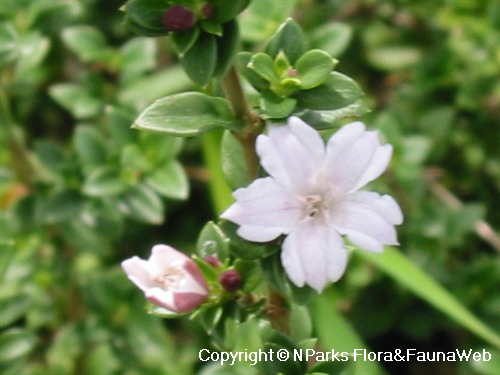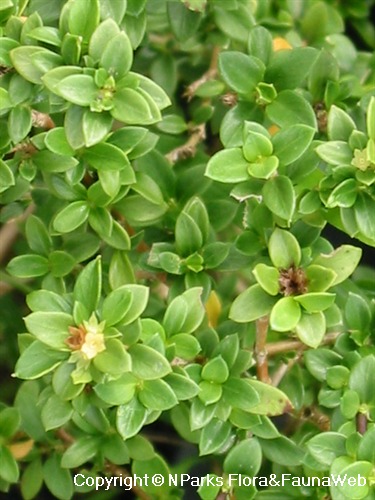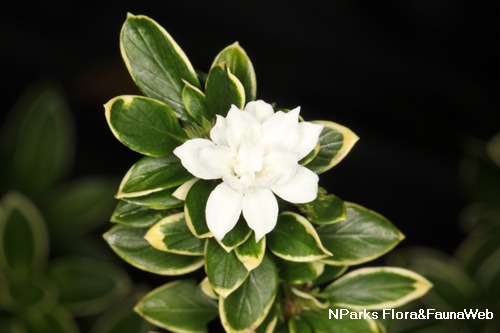
Back
Serissa japonica (Thunberg) Thunberg
| Family Name: | Rubiaceae |
| Synonyms: | Serissa foetida (L.f.) Lam. |
| Common Name: | Japanese Serissa, Snowrose, Tree of a Thousand Stars, Japanese Boxthorn, 六月雪, 白马骨, 满天星 |
Name
Classifications and Characteristics
| Plant Division | Angiosperms (Flowering Seed Plants) (Dicotyledon) |
|---|---|
| Plant Growth Form | Shrub |
| Lifespan (in Singapore) | Perennial |
| Mode of Nutrition | Autotrophic |
| Plant Shape | Rounded, Shrubby |
| Maximum Height | 0.5 m to 1 m |
Biogeography
| Native Distribution | India, China and Japan |
|---|---|
| Native Habitat | Terrestrial (Monsoon Forest, Mountain, Riverine) |
| Preferred Climate Zone | Sub-Tropical / Monsoonal |
| Local Conservation Status | Non-native |
Description and Ethnobotany
| Growth Form | It is a shrub, up to a metre tall. Its branches are somewhat flattened and finely hairy. |
|---|---|
| Foliage | Its shortly stalked, oppositely arranged leaves have thick leaf blades that are ovate to lanceolate,, 0.6-2.2 cm long and 0.3-0.6 cm wide. |
| Flowers | Its small, tubular, pinkish to white flowers that are 6-petaled, borne singly or in bunches, about 1 cm wide. |
| Fruit | Its fruits are drupes, 2-3 mm long. |
| Habitat | It grows along streams and in hilly forests. |
| Cultivation | Likes well-drained soil, prone to rotting in waterlogged soil. Over or underwatering, too little humidity may cause foliage yellowing and leaf drop. |
| Etymology | Latin, Serissa, from the Indian vernacular name for Serissa foetida (now known as Serissa japonica). Latin japonica, from Japan, referring to one its localities in its natural distribution. |
| Ethnobotanical Uses | Others: Popularly used as bonsai (esp. in Japan). When pruned, many branches produced from new and old wood. |
Landscaping Features
| Landscaping | It is suitable as a park plant for its ornamental form, leaves and flowers. |
|---|---|
| Desirable Plant Features | Fragrant (Flowers, Foliage, Stems) (Time Independent), Ornamental Flowers, Ornamental Foliage, Ornamental Form |
| Landscape Uses | Suitable for Bonsai, General, Container Planting, Parks & Gardens, Small Gardens, Riverine |
| Thematic Landscaping | Zen / Minimalist Garden |
| Plant & Rootzone Preference or Tolerance Remarks | Prone to root rot in waterlogged soils. |
Fauna, Pollination and Dispersal
| Pollination Method(s) | Biotic (Fauna) |
|---|---|
| Seed or Spore Dispersal | Biotic (Fauna) |
Plant Care and Propagation
| Light Preference | Semi-Shade, Full Sun |
|---|---|
| Water Preference | Moderate Water |
| Plant Growth Rate | Moderate |
| Rootzone Tolerance | Well-Drained Soils |
| Maintenance Requirements | Moderate |
| Diseases | Scale insects. Yellowing leaves and leaf-drop caused by incorrect placement, poor humidity levels or incorrect watering. |
| Propagation Method | Stem Cutting |
Foliar
| Foliage Retention | Drought / Semi-Deciduous, Evergreen |
|---|---|
| Mature Foliage Colour(s) | Green |
| Mature Foliage Texture(s) | Smooth, Thick |
| Foliar Type | Simple / Unifoliate |
| Foliar Arrangement Along Stem | Whorled, Opposite |
| Foliar Attachment to Stem | Petiolate |
| Foliar Shape(s) | Non-Palm Foliage (Oval, Lanceolate, Elliptical) |
| Foliar Venation | Pinnate / Net |
| Foliar Margin | Entire |
| Foliar Apex - Tip | Acute |
| Typical Foliar Area | Microphyll ( 2.25cm2 - 20.25 cm2 ) |
| Leaf Area Index (LAI) for Green Plot Ratio | 4.5 (Shrub & Groundcover - Dicot) |
Non - Foliar and Storage
| Trunk Type (Non Palm) | Woody |
|---|---|
| Bark Colour(s) | Light grey |
| Stem Type & Modification | Woody |
| Root Type | Underground (Tap Root, Fibrous Root) |
Floral (Angiosperm)
| Flower & Plant Sexuality | Bisexual Flowers |
| Flower Colour(s) | White, Pink |
|---|---|
| Flower Grouping | Solitary, Cluster / Inflorescence |
| Flower Location | Axillary |
| Flower Symmetry | Radial |
| Flowering Period | Free-Flowering |
| Flowering Opening Time | Time-Independent |
| Flower Lifespan on Plant | Several Weeks |
| Flowering Habit | Polycarpic |
Fruit, Seed and Spore
| Fruit Classification | Simple Fruit |
|---|---|
| Fruit Type | Fleshy Fruit , Non-Accessory Fruit |
Image Repository
Others
| Master ID | 1160 |
|---|---|
| Species ID | 2453 |
| Flora Disclaimer | The information in this website has been compiled from reliable sources, such as reference works on medicinal plants. It is not a substitute for medical advice or treatment and NParks does not purport to provide any medical advice. Readers should always consult his/her physician before using or consuming a plant for medicinal purposes. |


